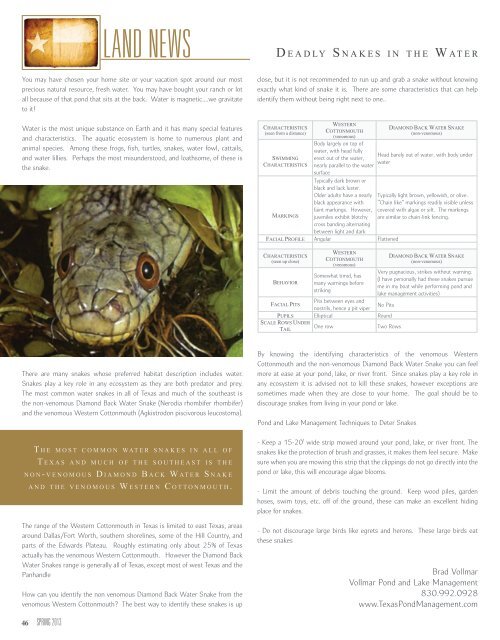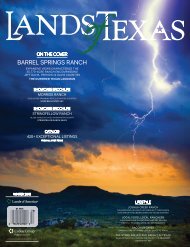Create successful ePaper yourself
Turn your PDF publications into a flip-book with our unique Google optimized e-Paper software.
<strong>LAND</strong> NEWS<br />
D e a d ly S n a k e s i n t h e W at e r<br />
You may have chosen your home site or your vacation spot around our most<br />
precious natural resource, fresh water. You may have bought your ranch or lot<br />
all because of that pond that sits at the back. Water is magnetic....we gravitate<br />
to it!<br />
Water is the most unique substance on Earth and it has many special features<br />
and characteristics. The aquatic ecosystem is home to numerous plant and<br />
animal species. Among these frogs, fish, turtles, snakes, water fowl, cattails,<br />
and water lillies. Perhaps the most misunderstood, and loathsome, of these is<br />
the snake.<br />
close, but it is not recommended to run up and grab a snake without knowing<br />
exactly what kind of snake it is. There are some characteristics that can help<br />
identify them without being right next to one..<br />
CHARACTERISTICS<br />
(seen from a distance)<br />
SWIMMING<br />
CHARACTERISTICS<br />
MARKINGS<br />
WESTERN<br />
COTTONMOUTH<br />
(venomous)<br />
Body largely on top of<br />
water, with head fully<br />
erect out of the water,<br />
nearly parallel to the water<br />
surface<br />
Typically dark brown or<br />
black and lack luster.<br />
Older adults have a nearly<br />
black appearance with<br />
faint markings. However,<br />
juveniles exhibit blotchy<br />
cross banding alternating<br />
between light and dark<br />
FACIAL PROFILE Angular Flattened<br />
DIAMOND BACK WATER SNAKE<br />
(non-venomous)<br />
Head barely out of water, with body under<br />
water<br />
Typically light brown, yellowish, or olive.<br />
“Chain like” markings readily visible unless<br />
covered with algae or silt. The markings<br />
are similar to chain-link fencing.<br />
CHARACTERISTICS<br />
(seen up close)<br />
BEHAVIOR<br />
WESTERN<br />
COTTONMOUTH<br />
(venomous)<br />
Somewhat timid, has<br />
many warnings before<br />
striking<br />
FACIAL PITS<br />
Pits between eyes and<br />
nostrils, hence a pit viper<br />
No Pits<br />
PUPILS Elliptical Round<br />
SCALE ROWS UNDER<br />
One row<br />
TAIL<br />
Two Rows<br />
DIAMOND BACK WATER SNAKE<br />
(non-venomous)<br />
Very pugnacious, strikes without warning.<br />
(I have personally had these snakes pursue<br />
me in my boat while performing pond and<br />
lake management activities)<br />
There are many snakes whose preferred habitat description includes water.<br />
Snakes play a key role in any ecosystem as they are both predator and prey.<br />
The most common water snakes in all of <strong>Texas</strong> and much of the southeast is<br />
the non-venomous Diamond Back Water Snake (Nerodia rhombifer rhombifer)<br />
and the venomous Western Cottonmouth (Agkistrodon piscivorous leucostoma).<br />
T h e m o s t c o m m o n wat e r s n a k e s i n a l l o f<br />
T e x a s a n d m u c h o f t h e s o u t h e a s t i s t h e<br />
n o n - v e n o m o u s D i a m o n d B a c k W at e r S n a k e<br />
a n d t h e v e n o m o u s W e s t e r n C o t t o n m o u t h .<br />
The range of the Western Cottonmouth in <strong>Texas</strong> is limited to east <strong>Texas</strong>, areas<br />
around Dallas/Fort Worth, southern shorelines, some of the Hill Country, and<br />
parts of the Edwards Plateau. Roughly estimating only about 25% of <strong>Texas</strong><br />
actually has the venomous Western Cottonmouth. However the Diamond Back<br />
Water Snakes range is generally all of <strong>Texas</strong>, except most of west <strong>Texas</strong> and the<br />
Panhandle<br />
How can you identify the non venomous Diamond Back Water Snake from the<br />
venomous Western Cottonmouth? The best way to identify these snakes is up<br />
By knowing the identifying characteristics of the venomous Western<br />
Cottonmouth and the non-venomous Diamond Back Water Snake you can feel<br />
more at ease at your pond, lake, or river front. Since snakes play a key role in<br />
any ecosystem it is advised not to kill these snakes, however exceptions are<br />
sometimes made when they are close to your home. The goal should be to<br />
discourage snakes from living in your pond or lake.<br />
Pond and Lake Management Techniques to Deter Snakes<br />
- Keep a 15-20’ wide strip mowed around your pond, lake, or river front. The<br />
snakes like the protection of brush and grasses, it makes them feel secure. Make<br />
sure when you are mowing this strip that the clippings do not go directly into the<br />
pond or lake, this will encourage algae blooms.<br />
- Limit the amount of debris touching the ground. Keep wood piles, garden<br />
hoses, swim toys, etc. off of the ground, these can make an excellent hiding<br />
place for snakes.<br />
- Do not discourage large birds like egrets and herons. These large birds eat<br />
these snakes<br />
Brad Vollmar<br />
Vollmar Pond and Lake Management<br />
830.992.0928<br />
www.<strong>Texas</strong>PondManagement.com<br />
46 SPRING <strong>2013</strong>

















